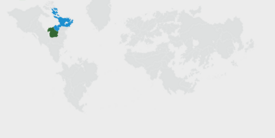Mniohuta
Confederation of Mniohuta ᐅᔭᑌ ᒼᓂᐅᐦuᑕ 1 official name
| |||
|---|---|---|---|
Coat of Arms
| |||
| Motto: «ᐁᓬ ᖧᐊuᑲ ᓬᔪᑎᔦᑭᔭ, ᐅᐘuzᐁᐃᓬᐊ᙮» "In great endeavor, union." | |||
| Anthem: ᐅᐩáᑌ ᐅᓬóᐘᐣ Oyáte Olówaŋ "Song of the Nation" | |||
| [[File:|frameless|275px]] PUT MAP NAME THERE Location of Mniohuta on Earth. Claimed territory in light green. | |||
 Political Map of Mniohuta | |||
| Capital | Wokheya | ||
| Largest city | Walgroinzin | ||
| Official languages | Mniyapi | ||
|regional_languages =
|languages_type = |languages =
|ethnic_groups =
|ethnic_groups_year = 2020
|religion =
- 21% Irreligious
- 63% Template:Mniohuta
- 5% Template:Mniohuta
- 11% Other
|demonym = Mniohutan
Mnohati (plural)
|government_type = Parliamentary federated constitutional monarchy
|leader_title1 = Premier
|leader_name1 = Chaska Chimaka
|leader_title2 = Chief of the Council
|leader_name2 = Odakota Akecheta
|legislature = Conclave of the Confederacy
|upper_house = Council of Elders
|lower_house = Council of the People
|sovereignty_type = Independence
|sovereignty_note = from Tyrrslynd
|established_event1 = Event
|established_date1 = DATE
|area_rank =
|area_magnitude =
|area =
|area_km2 = 897,115
|area_sq_mi =
|area_footnote =
|percent_water = 5
|area_label = Total area
|area_label2 =
|area_dabodyalign =
|population_estimate =
|population_estimate_rank =
|population_estimate_year =
|population_census = 26,431,592
|population_census_year = 2020
|population_density_km2 = 30.19
|population_density_sq_mi =
|population_density_rank =
|GDP_PPP =
|GDP_PPP_rank =
|GDP_PPP_year =
|GDP_PPP_per_capita =
|GDP_PPP_per_capita_rank =
|GDP_nominal = $NEED TO ENTER
|GDP_nominal_rank =
|GDP_nominal_year = 2020
|GDP_nominal_per_capita = $NEED TO ENTER
|GDP_nominal_per_capita_rank =
|Gini = NEED TO FIGURE OUT
|Gini_rank =
|Gini_year = 2015
|Gini_change = increase
|Gini_category =
|HDI = NEED TO ENTER
|HDI_rank =
|HDI_year = 2015
|HDI_change = increase
|HDI_category =
|currency = Mniohutan mazaska (₼)
|currency_code =
|time_zone = UTC -5
|utc_offset =
|time_zone_DST =
|antipodes =
|date_format = dd/mm/yyyy
|DST_note =
|utc_offset_DST =
|drives_on = right
|cctld = .mt
|calling_code = +68
|national_animal =
|image_map3 =
|alt_map3 =
|footnote_a =
|footnote_b =
}}
Mniohuta (/[invalid input: 'M']ɑː[invalid input: 'ni']oʊ[invalid input: 'hu'][invalid input: 'taː']n/ muh-nee-O-hu-ta), officially the Confederacy of Mniohuta, is a country in northeastern Norumbia. Its 15 commonwealths cover a peninsula of around 897,115 square kilometers (346,378 square miles), bordered by Elatia to the Northwest, Lake Thanka to the West, Winivere Bay to the North, Awasin and Moxaney to the Northeast, the Chenes to the West, and Gristol-Serkonos to the South. (description of populations and where they likely live)). The capital, biggest city, a few other cities. Description of the people.
Various indigenous peoples have inhabited what is now Wazheganon since the last ice age. The earliest written records from Wazheganon are found on birchbark scrolls dating back to the 12th century. Historically, the dominant political model was that of the mawaċimau, in which kinship groups formed loose confederations based on cultural ties. While contact with Belisarians was made as early as the 12th century, incursions into modern Wazheganon were largely repelled until the Great Lake War in the late 16th century, when Ottonian Tyrrslyndic colonizers advanced on weakened and disorganized coastal confederacies, forcibly displacing local populations and repopulating newly conquered land with Kamryker settlers from Onneria. Several of these Tyrrslyndic colonies gained independence in 1733 as Valzia, and expanded into the continental interior in a series of protracted and deadly wars with indigenous polities, culminating in the Asherionic Wars in which a pan-indigenist revolution led to the brief conquest of much of eastern Norumbia.
The Waltzing Coups period dominated Wazhenaby politics for much of the 19th century, causing significant political turmoil and popular unrest. Beginning in the 1880s, the country saw a series of socialist reforms and uprisings which eventually culminated in the Wazhenaby Civil War from 1919 to 1921. Afterwards, the new Wazhenaby Federal Socialist Republic experienced several smaller ideological upsets before finally galvanizing into the contemporary political structure in 1957. Significant reforms in pursuit of decolonization took place in the 1970s and 1980s.
Wazheganon is a libertarian socialist federation in the communalist tradition, consisting of 1,732 autonomous communes and 15 nominally independent commonwealths, with a unicameral legislature which elects a steering committee to carry out executive functions in a system of council democracy. It maintains a decentralized hybrid-socialist economy in which basic needs have been decommodified and all businesses are either worker-owned or state-operated. Major industries and products include foodstuffs, forest products, commercial vehicles, industrial machinery, telecommunications, and tourism. Wazheganon ranks highly in international measurements of political freedoms, government transparency, education, and quality of life. It is a member of several international organizations and alliances, including the Forum of Nations, Joint Space Agency, Kiso Pact, Global Observatory of Labor, Common Congress of Oxidentale and Norumbia, and Osawanon Community.
Etymology
The origins of the name
Demonyms
A
Official title
B
Geography
A
Climate
ABC
History
Evidence of human habitation in what is now Mniohuta dates back to at least DATE BCE. Archaeological records suggest that
Early civilization
Formation of permanent settlements
The d.
Asherionic Wars
Unification of the eight tribes
Democratization and Industrialization
Contemporary History
Government and politics
Premier
Chief of the Council
Mniohuta is a federal, libertarian socialist council republic in the communalist tradition. TEXT TEXT TEXT TEXT.
The Chief of the Council of the House of... premier .
Law
Legal system.
Mniohuta and also description.
Foreign relations
Since the Title and resulting political ...
Military
When the
Constituencies
Description of civil organization and of prefectures(?).
| Commonwealth | Capital | Population | |
|---|---|---|---|
| File:Flag of Walzenia modern.png Wazheganon - Confederacy of Mniohuta | Capital | Population | |
| File:Flag asd.svg Name - Name title | Zorai | 6,201,418 |
Economy
Wazheganon is an industrialized country with a high standard of living.
Agriculture
Energy
Tourism
Transporation
Science and technology
Demographics
With a population of X then Y Template:Largest cities in Mniohuta
Ethnic groups
DESCRIPTION THATS REALLY AWESOME:
- NAME 1: YEAH BABY.
- NAME 2: WHEN WHEN YOU.
Additionally, there are countless immigrant communities which do not fit into any of these groups.
Languages
While Wazheganon has no official language at a federal level, Wazhewen is spoken by the vast majority of the population and used in most official proceedings. It is a creole language that developed alongside the Mezhteg in the 17th-19th centuries and draws influences from a variety of Belisarian and Norumbian languages, most notably Umbiaans, Nordic, Masenomaweq, and Onigamymowin. It is not mutually intelligible with any of these languages. There is no legal authority which regulates or controls the Wazhewen language.
Many Wazhenabyg are multilingual, often speaking both Wazhewen and a local or regional language, and often learning a third language in school, such as Nahuatl, Allamunic, or Tsurushimese. While are 10 official languages which are spoken at a commonwealth-level, including Wazhewen, there are hundreds of other minority languages spoken at home and in immigrant communities. The second most spoken language after Wazhewen is Umbiaans, followed by Onigamymowin.
Religion
Mniohuta time baby..
Education
H.
Health
H.
Culture
1
Architecture
Mnio ysdgjesngewojgweewg.
- Swaglord21 002.jpg
Yeah.
- Wowthatscrazy.jpg
Description.
Cinema
Maybe
Clothing
Swag.
Cuisine
time to talk to hiero.
Holidays
swag day.
Literature
edgar allen ur mom.
Sports
woooo sports ball baby.
- ↑ Since the unification of the eight tribes most of the more minor tribes were absorbed by the larger ethnic groups such as the Thituwan, Hetuwa, Mniwa, or were already fairly closely related.








